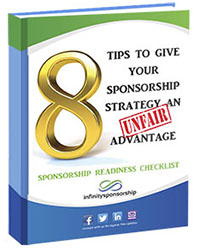There are many reasons why companies and brands may decide not to invest in sponsorship opportunities – their budgeting cycle was missed; misalignment of target markets; the approach and proposal were too generic; no clear opportunities for the company or brand to participate; no measurability or opportunity for return on investment; untried and untested opportunities, techniques or benefits; and worst of all – unmaintained relationships.
What if there were proven methods that you could incorporate into your sponsorship approach that would give you the opportunity to exponentially improve your chance of success? Below are the crucial steps required to improve your sponsorship proposal and make your ideal sponsor excited to partner with you.
Research that rocks!
In the world of sponsorship, the importance of creating a relationship with a company or brand beforeyou send them a proposal cannot be overstated. When you decide that you are ready to seek and engage corporate partners, there are key things that you will need to know about a company before you can decide whether the alignment is right; simply needing funding is not enough.
Speaking with a company before you send them a proposal will elevate you into the minority of not-for-profit (NFP) organisations seeking sponsorship. Taking the time to be curious about what a company might be hoping to achieve through a partnership and asking what sponsors want should be the norm, not the exception.
Examples of key things you should research about your target company include:
- If they have ever partnered with a NFP before
- Other organisations they are currently sponsoring
- Best timing of proposal – 43 per cent of companies organise their budgets between September and November each year
- The best person to speak with about sponsorship
- Whether or not they would be interested in what you have to offer.
It’s not a ‘levels’ playing field!
Generic packages – bronze, silver and gold – are more about your convenience than your sponsor’s. These packages were creative and interesting a decade ago, but over the years they have been done to death. Being flexible is paramount – a win-win outcome will be best achieved from knowing inside and out all the channels you currently use to communicate with your members, audience, and community; being prepared to listen to your sponsor’s desired outcomes; and then finding the best mix of options that suits everyone.
How to make a so-so proposal look amazing!
Using the right images can immediately engage your reader, and more importantly, it may mean that your proposal is the one that gets picked to be read, over all the others. There are many websites that provide great images. You will usually have to pay to use them, but if they are relevant to your mission and audience, you can use them again and again in your own marketing collateral. The more professional your organisation looks, the more investment you can command. It is an easy equation. You only have one chance to make a first impression, so do everything you can to look your best.
Invitations that can’t be refused
When you invite a company to partner with you, there are two aspects that are non-negotiable to cover if you want to progress to the next stage of meeting with a company or brand. Firstly, be sure to show the company you understand what they are looking for; and secondly, position your organisation or event as the best way to help them get what they want.
Your invitation to prospective partners must strongly convey the message “We understand what you are looking for and we can help you become more successful through a partnership”. The more you incorporate your potential partner’s aims into your proposal, the more they will be excited about the prospect of working with you.
Being a ‘good cause’ won’t get you sponsored
When a potential sponsor scrutinises your sponsorship proposal, the first things that will come to mind are: What’s in it for me? How will this make our company/brand more successful? How can we sell more products and services as a result of this partnership? What is the likely return on investment that we can expect?
As much as people may align with your mission and deeply believe in what you do for your community, sponsorship decisions will not be based on anything emotive or immeasurable. You will need to include brief details about all the ways you can leverage access to the people you serve – your members, audience, industry or community.
Sell yourself as the exclusive connection!
Your organisation is a valuable marketing partner to a potential sponsor. The unique thing about partnering with the NFP sector is that your community or members are not mandated to be aligned with your organisation. They stick with you because they trust you and value the information, advocacy, voice, education, support that you give them.
Many companies do not understand this concept right away, so it is your job to educate a potential sponsor about the powerful position you are in to help them access a market they are not currently doing business with. Your alignment will give them much better ‘cut through’ when they interact with your audience, whereas ‘going it alone’ and trying to reach your members without you would be considered spam by your community. Aligning with your brand provides your potential partner an invitation to ‘meet the family’.
It’s not what you know…
In any proposal, sponsors like to see who they will be dealing with. When asking a company to invest in you, do not assume they are familiar with your organisation. It is important to provide a page that highlights the key people a company can expect to deal with. Remember to include your CEO – other CEOs, managing directors and general managers will want to deal with someone of a similar title.
The price is right!
Sponsorship in the NFP sector is the cheapest form of marketing for the right companies. Through partnership, a potential partner can reach its ideal target market, and this can be a compelling argument for certain businesses if pricing is suitable.
Rather than focusing on what a partnership will cost you to service, or how much you will spend getting your event up and running, consider instead: what would access to the ideal target market be worth to a sponsor? That will get you closer to the amount you need and give you a better chance of creating a partnership based on shared values, rather than you giving away everything for too little in return.
When you are seeking a company or brand to invest time and money in partnering with you, make sure you do everything you can to put your best foot forward to create a successful relationship long into the future.
Remember that by including these steps in your approach, you are immediately differentiating yourself from the 700,000 other charities and associations out there seeking funding through sponsorship.





